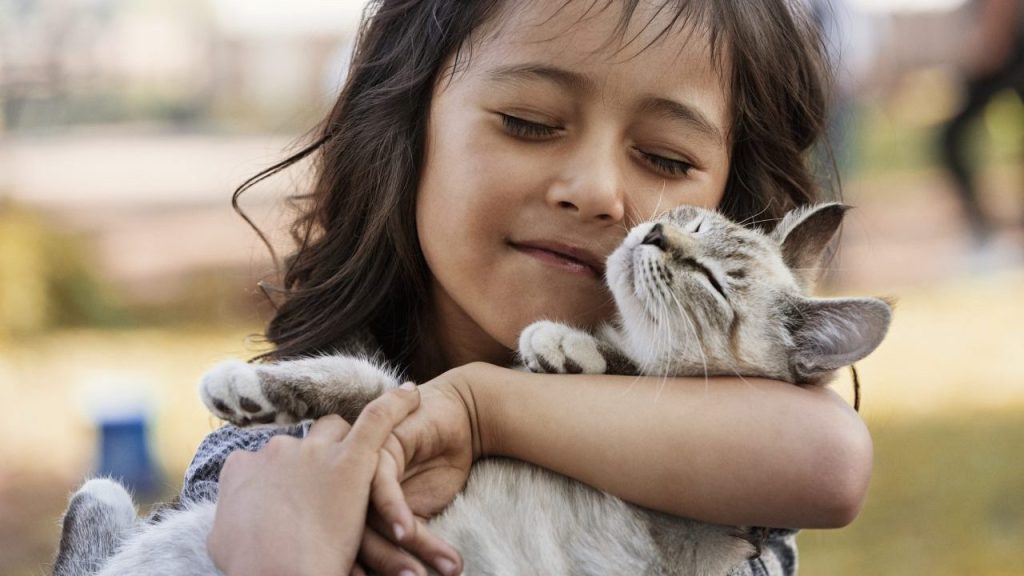You’ve deliberated and debated and finally made the leap (a favorite feline move) and adopted a four-legged friend for your family. Your kids are likely over the moon by the arrival of their new furry family member, but keeping both kids and cats safe in one another’s presence can be challenging. Cats require delicate handling and respect from everyone, including children. Teaching kids to be gentle with cats not only fosters a safe and loving environment for both the child and the feline companion but also helps cultivate empathy and responsibility in young minds. We’re going to outline five important lessons parents can impart to their children to ensure they treat cats with the care and kindness they deserve.
Helping children be gentle with cats
Lesson 1: Respect personal space
Children should understand that cats, like humans, value their personal space. It’s crucial to teach them to recognize when a cat needs their alone time or wants to retreat to their safe space, such as a cat bed or hiding spot. Explain to your child that forcing attention on a cat that wants to be left alone can lead to stress and potential aggression from the cat. Encourage your child to observe the cat’s body language and signals, such as flattened ears or a swishing tail, which indicate that the cat needs space.
Lesson 2: Gentle touch and petting
Teaching children the art of gentle touch is paramount when interacting with cats. Demonstrate and explain to your child how to use soft strokes and avoid pulling or tugging on the cat’s fur or tail. Emphasize the importance of using an open hand and allowing the cat to approach for petting rather than forcing contact. Remind your child to avoid sensitive areas like the belly or paws, as some cats may not enjoy being touched in those areas. Encourage your child to ask for permission before petting a cat and to listen to the cat’s cues if it shows signs of discomfort.
Lesson 3: Proper handling techniques
It’s essential to teach children how to handle cats properly, especially when picking them up. Instruct your child to support the cat’s entire body, placing one hand under the chest and the other supporting the hindquarters. Explain that this helps the cat feel secure and prevents unnecessary strain or discomfort. Reinforce the notion that cats should never be lifted by their tails or carried awkwardly, as this can cause injury or distress.
Lesson 4: Playtime boundaries
Cats love to play, but it’s crucial for children to understand the importance of setting boundaries during playtime. Teach your child that rough play, such as pulling the cat’s tail or ears, is unacceptable and can lead to scratches or bites. Encourage your child to engage in interactive play using appropriate toys like feather wands or small balls, while maintaining a safe distance from the cat’s claws. Teach them that playtime should be fun and stimulating for both the cat and themselves, but always with gentle and controlled movements.
Lesson 5: Patience and empathy
Instilling patience and empathy in children helps them develop a deep understanding and appreciation for their feline friends. Explain to your child that cats have their own unique personalities, and some may be more reserved or less inclined to interact at certain times. Teach them to respect the cat’s boundaries and to be patient, allowing the cat to approach and initiate interaction on its terms. Encourage your child to observe the cat’s behavior and respond accordingly, fostering empathy and understanding of the cat’s needs and emotions.
Teaching your cat to be gentle with kids
While it’s important to teach children to be gentle with cats, it’s equally crucial to train your cat to live harmoniously with children. Help your cat develop positive associations with children by rewarding them with treats or praise whenever they are calm and tolerant in the presence of children. Encourage children to offer treats to the cat gently and to engage in calm play sessions. This will reinforce positive experiences and help the cat associate children with pleasant interactions.
Helping cats and kids coexist
Teaching children to be gentle with cats is a vital lesson in fostering respect, empathy, and responsible pet ownership. By imparting these lessons, parents can help create a loving and safe environment for both their children and their feline companions. Remember, nurturing a positive relationship between children and cats not only enhances the well-being of both, but also lays the foundation for a lifelong bond built on love and mutual understanding.
Now that you know how to teach children to be gentle with cats, check out the best kid-friendly cat breeds and family-friendly cat breeds.









